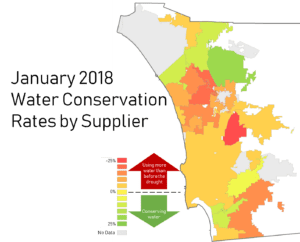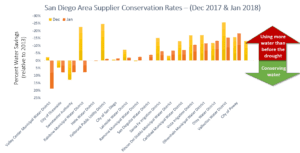Recent numbers on urban water use in our region have illuminated a less-than-stellar trend: Many of our area water suppliers are reporting negative conservation rates in December and January, meaning we’re using more water now than we were before the drought even started.
It’s both surprising and disappointing to see our region’s water use has been creeping up over the last few months. The State Water Board continues to release monthly reports on urban water use as reported by local suppliers, and January’s numbers were consistent with a trend of increased usage in our region.
Despite coming on the heels of years of water scarcity and dry conditions, the extraordinarily wet winter of 2016-17 led regulators to declare an “end to the drought,” and messaging has been mixed about the need for saving water ever since. One wet winter in years of dry ones is like paying $100 of a $1,000 credit card bill. It’s a good and welcome start, but it doesn’t mean you’re out of the woods. Unfortunately, that’s just how the “end of drought” declaration was interpreted. With the cessation of emergency drought regulations came the end of mandatory conservation targets, but not the end of the need to conserve. Unfortunately, some interpreted the declaration as a free ticket to return to water wasteful ways.
In the most recent report, water use in January in the City of San Diego was up by 1.4 percent when compared to January 2013. This may not seem like much, but considering all the work over recent years towards improving water efficiency and building long-term water smart communities, it’s disheartening – and somewhat astonishing – to see us losing any ground. Other suppliers in our region reported usage at rates as much as 18 percent higher (City of Poway), 16 percent higher (Vallecitos Water District), 13 percent higher (Otay Water District), and 11 percent higher (Olivenhain Municipal Water District) than in January 2013, the year before the emergency drought declaration in California, and the baseline by which we compare water usage to get conservation rates. The Santa Fe Irrigation District, which has repeatedly made headlines for being one of the highest water users in the entire state, surged past their pre-drought January rate of 230 gallons per capita per day to over 251 gallons per capita per day in January of this year.
Looking back since July 2014 when the state began gathering water production information from urban water suppliers, there is some good news and some bad news in the data. On one hand, we’ve been pretty good at conserving water, as shown by lower water use during most months, compared to the year 2013. However, only about 50 percent of the time have we met or exceeded the target 16 percent reduction in water use that was assigned to the City of San Diego during the drought by the State Water Board as part of a plan to achieve a 25 percent reduction statewide. And recently, we’ve failed to conserve any water at all relative to our use in 2013. On the plus side, this data shows us that we are capable of conservation, but there is still considerable room for improvement.
Only the City of Oceanside and Sweetwater Authority used water at rates that continue to be lower than pre-drought usage in both December and January.
The fact is that whether or not we are in a drought, San Diego relies almost entirely on water that is imported from other regions, namely the Colorado River basin or Northern California’s Bay-Delta. These imports have huge economic, energy, and environmental costs that are too often ignored in favor of shoring up supply for San Diego’s thirsty water habits. Conservation is easier and cheaper than costly imports or energy-intensive desalination, and needs to come first when it comes to long term water use strategies. As one of the regions with the least local water supplies, we should be leading the conservation race, not lagging behind and making excuses.
It appears that without consistent, frequent messaging about the importance of saving water, our region continues to take water for granted. Now, drier than normal conditions are back across much of the west and it’s time to make efficient water use a permanent way of life in San Diego.
We’re continuing to keep tabs on these trends so stay tuned for updates on February’s conservation reports from the State Water Board, which should be released soon.















